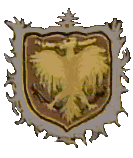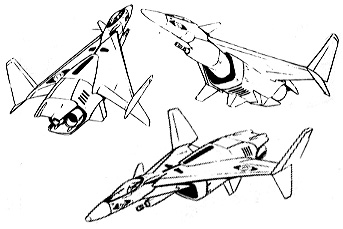

Designation: Mikoyan i Gurevich 31 Karyobin Jet Fighter
|

|

|
|||

|
|||||
| MiG-31 | A-16A, -B | A-16C, -D | ||
|---|---|---|---|---|
| Total Length: | 16.5 m | 16.5 m | 17.9 m | |
| Total Height: | 6.4 m | 6.4 m | 6.4 m | |
| Total Wingspan: | 9.7 m | 9.7 m | 9.7 m | |
| Total Dry Weight: | 12.3 | 13.6 | 14.1 | metric tons |
Typical set for A-16B variant
(A and B variants)
8 hardpoints for assorted ordnance, 3 under each wing and 2 under the inlet. The hardpoints are not conformal and can carry MERs (Multiple Ejector Racks). Typical loads carried are:
(C and D variants)
3 conformal hardpoints for Carapace missile containers under the inlet. These missile containers can contain 6 Diamondback missiles, 12 Hammerhead missiles, or 3 Stiletto missiles. Typically, two Carapaces contain Diamondbacks, and the other Carapace contains Hammerhead missiles for a total of 12 Hammerhead and 12 Diamondback missiles.
6 standard hardpoints, three under each wing, suited for MERs. Typical loads carried are:
The skin of the Karyobin is composed of an titanium-steel alloy on vital spots. Other sections of the skin are composed of advanced carbon-plastics. The skin on the Karyobin provides excellent protection in the vital spots against small grenade and shell fragments, good protection against small arms fire, and poor resistance to heavier infantry weapons, such as the 12.7mm machinegun round, as well as from fragments and near misses from higher caliber weapons.
The skin of the Executioner is composed of an advanced titanium-steel alloy. The armor on the Executioner stops all small arms fire, provides fair protection against heavier infantry weapons, such as a 12.7mm machinegun round, and poor resistance to light mecha-mounted weaponry, such as the Zentraedi 22.3mm HE autocannon round. The armored 'bathtub' in the Executioner's pilot compartment stops all small arms fire, provides good protection against heavier infantry weapons, such as a 12.7mm machinegun round, and fair resistance to light mecha-mounted weaponry, such as the Zentraedi 22.3mm HE autocannon round.
These planes provide full protection from nuclear, biological, and chemical hazards, using an overpressure cockpit environment activated by radiation and hazardous chemical sensors, or manually when biological warfare conditions are anticipated. The internal consumables supplies can provide atmosphere for approximately eight hours.
During the GCW, the Mikoyan-i-Gurevich Design Bureau designed its own equivalent to both the Fairchild A-10 Thunderbolt and the McDonnell-Douglas F/A-18 Hornet. The new aircraft would have to be as effective at taking out ground targets as the A-10, but also as adept at air-to-air combat as the dual-role F/A-18. The design bureau fulfilled these hefty demands brilliantly with the MiG-31. The plane incorporated completely new aerodynamical designs, including a delta wing tipped with the vertical stabilizers, which were in effect very large winglets, and two small canard wings in front. The cockpit section was an ellipsoid, and the main hull extended above and below the wings. Expert detail design and applied aerodynamics, coupled to thrust reversers and revised approach procedures gave the plane the STOL capability of the far older SAAB Draken and Viggen fighters. The MiG-31 was well armored, and had built-in infra-red engine suppressors to counter aircraft-and shoulder-launched infra-red missiles. The armament was impressive, with a 30mm four-barreled Gatling cannon under the hull, in front of the inlet. This cannon was a knock-off of the GAU-8/A as installed in the nose of the A-10, and fired similar powerful ammunition. The one drawback was that exhaust fumes from the cannon's firing could interfere with the engines, but this was offset by a number of auxiliary inlets and close-off doors in the normal airflow canals. Four hardpoints were also available to mount almost any external store available in the world. The resulting craft was even faster at low altitudes than the F-203, but was still not as good a dog-fighter due to the lower thrust of its engines and its higher weight, causing a lower acceleration and more energy loss during sustained turns. However, as a dual-role attack/fighter aircraft the plane was without equal, surpassing both the A-10 as a ground attack plane and the F/A-18 as a dual-role plane. The USSR was very pleased with the design, since it was an overnight success, and sold a large number to the East-bloc and Chinese forces where it acquired the name of Karyobin. After Earth's unification, the UNDF gladly adopted a variant of this plane, renamed the A-16A Executioner, as its main ground-attack aircraft. The radar/EW suite was upgraded, and the plane's armor and engines were improved, with the intent of changing the plane from a multi-role fighter into primarily an attack plane. An additional four hardpoints were added under the wings, and the gun upgraded to a 35mm Armscor design. This variant served with the UNDF Air Force, and fought its Russian predecessor on several occasions, as these aircraft still served with anti-unification forces.
In 2010, the Executioner was refit again. The A-16B saw its electronics upgraded to the standard UNDF suite, was given carrier compatibility, and the already powerful cannon was replaced with a GU-9, the single barrel version of the GU-11, the same cannon that equipped the QF-3000 Ghost drones. This weapon was reasonably effective against Zentraedi mecha. The A-16B Executioner was well-used during the Zentraedi uprisings.
In 2020, when almost all other forces had upgraded their combat aircraft with designs postdating the Robotech era, the Southern Cross Navy and TAF decided to acquire an improved model of the Executioner, rather than the new Bat, as their prime dual-role attack aircraft. The Executioner C (Navy) and D (Tactical Air Force) were the only pre-1999 designed models to be equipped with fusion turbines. This modification eliminated the dependence on fossil fuel sources, and gave the planes effectively supercruise capabilities and unlimited range. However, the former fuel tanks were not used as reaction-mass tanks, but rather simply deleted in favor of extra strengthening and the ASC standard electronics set. This meant that the fusion turbines could not be boosted, and that neither the speed nor the maximum altitude performance of the Executioner was greatly affected. In addition, the use of fusion turbines mandated a protoculture power source, and the installment of a protoculture generator provided enough excess current to replace the GU-9 cannon with the EP-4, the same particle cannon used on the VF-4 Lightning.
The main difference between the C and the D models was that the C model also incorporated secondary exhaust vents, which gave the plane a true VTOL capability, although take-off with a meaningful weapon load still required a (short) roll or catapult launch. This capability was required to operate the Executioner from the Daedalus-class vessels of the SC Navy. The TAF models would return to runways, not decks, and thus did not need the true VTOL modifications, and the D model was built without them. Both of the Southern Cross variants served until the Invid invasion.
Return to UNDF Aircraft Index.
Go to Robotech Reference Guide Home Page.
Robotech (R) is the property of Harmony Gold. This document is in no way intended to infringe upon their rights.
Content by Pieter Thomassen and Peter Walker